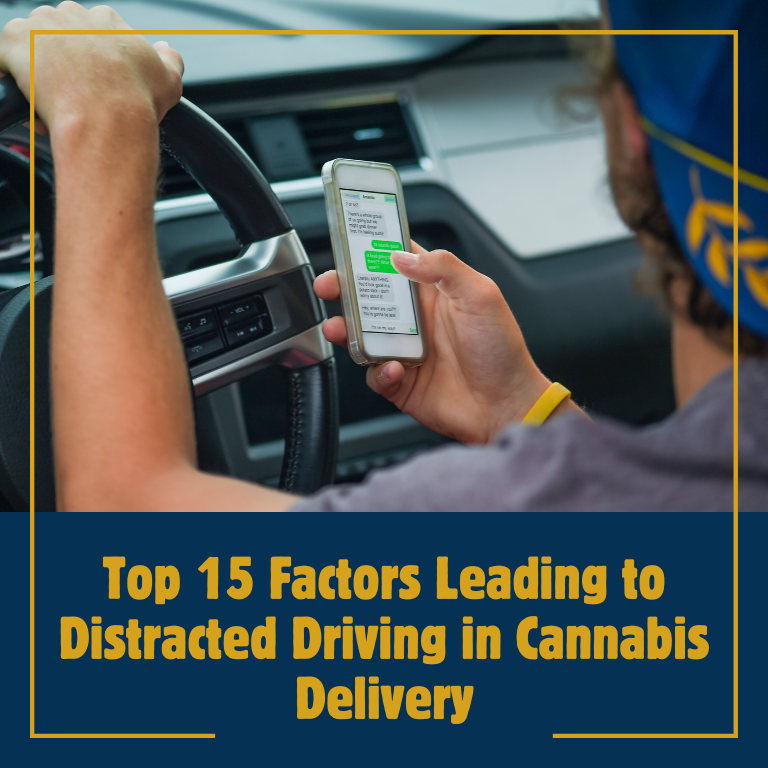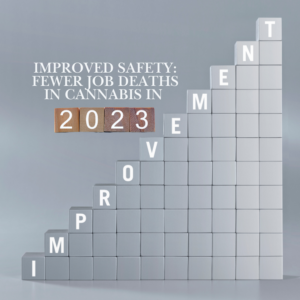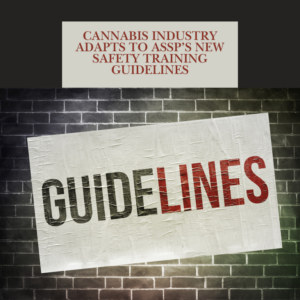Top 15 Factors Leading to Distracted Driving in Cannabis Delivery

The cannabis delivery industry is booming as the demand for convenience continues to rise with the expansion of legalized cannabis markets. However, cannabis delivery drivers, like all delivery personnel, face unique challenges on the road, including navigating traffic, meeting deadlines, and adhering to complex regulations. One of the most significant risks they face is distracted driving. Distracted driving can lead to accidents, property damage, injuries, and even fatalities.
In this article, we’ll explore the top 15 factors leading to distracted driving in cannabis delivery, providing insights on how these distractions can be mitigated to promote safer driving practices.
1. Mobile Device Use
One of the most prevalent causes of distracted driving is the use of mobile devices. Delivery drivers often rely on their phones or tablets for navigation, communication with customers, or checking delivery schedules. Constantly interacting with mobile devices can divert attention from the road, increasing the likelihood of accidents.
Invest in hands-free technology and encourage drivers to use voice commands for navigation and communication. Delivery apps can also be designed to minimize interaction during driving, such as providing clear instructions before the trip begins.
2. GPS and Navigation Systems
While GPS is essential for cannabis delivery drivers to efficiently navigate to unfamiliar locations, constant glancing at navigation devices can lead to distractions. Sudden re-routing, unclear instructions, or even confusing map displays can take a driver’s attention away from the road.
Use voice-guided navigation systems, so drivers can receive directions without having to look at their devices. Pre-plotting routes before the trip also helps reduce the need to check maps mid-drive.
3. Incoming Calls and Messages
Cannabis delivery drivers may receive calls or messages from dispatchers, customers, or colleagues while on the road. Answering calls or responding to messages can be a major distraction, even if done briefly. Drivers may feel pressure to answer quickly, leading to unsafe behavior.
Implement policies that discourage answering calls or messages while driving. Use automated status updates for customers to reduce the need for interaction during the delivery process.
4. Eating and Drinking
Given the demanding nature of cannabis delivery, drivers may not always have time to stop for meals. As a result, many drivers eat or drink while on the road. While this may seem like a small distraction, it requires taking at least one hand off the wheel and diverting attention from driving.
Encourage drivers to schedule breaks between deliveries to eat or hydrate. Additionally, providing guidance on safe driving habits can help reduce the temptation to eat or drink while driving.
5. Vehicle Controls and Adjustments
Adjusting vehicle controls such as air conditioning, radio, or seat positions can distract drivers from the task at hand. These minor adjustments can become a dangerous habit if done repeatedly during a trip.
Train drivers to adjust vehicle settings before starting their journey. Using voice-activated controls or steering-wheel-mounted buttons can also minimize the need to take hands off the wheel.
6. Roadside Distractions
From flashy billboards to roadside events, external distractions can easily capture a driver’s attention. For cannabis delivery drivers, who often work in urban areas, the temptation to glance at external distractions is heightened.
Promote the practice of focused driving, encouraging drivers to remain attentive to the road and surrounding vehicles rather than external distractions.
7. Fatigue and Drowsy Driving
Long hours, tight schedules, and late-night shifts can lead to fatigue for cannabis delivery drivers. Drowsy driving significantly impairs reaction time and decision-making, contributing to accidents.
Establish limits on the number of consecutive hours a driver can work. Encourage drivers to take breaks, get enough sleep, and monitor their health to prevent fatigue from becoming a serious hazard.
8. Passenger Interactions
While cannabis delivery drivers typically work alone, there are situations where they may have passengers, such as during training or multi-stop deliveries with coworkers. Engaging in conversations with passengers can lead to cognitive distractions, drawing attention away from the road.
Limit unnecessary conversations while driving. Ensure that any discussions related to work or deliveries are kept brief and concise.
9. Multi-tasking
Many cannabis delivery drivers feel the pressure to multi-task, juggling navigation, communication, and delivery management while driving. This can involve checking delivery statuses, responding to customer inquiries, or coordinating with dispatch, all of which can divert focus from the road.
Implement systems that automate or simplify tasks like route management and customer updates, reducing the need for multi-tasking while driving.
10. Weather Conditions
While not an intentional form of distraction, navigating through challenging weather conditions can lead to distractions as drivers adjust to changing road surfaces, visibility, and traffic patterns. Whether it’s rain, snow, or fog, drivers often need to split their attention between the environment and the road.
Provide training on driving in adverse weather conditions and equip delivery vehicles with the necessary safety features, such as anti-lock brakes, traction control, and all-weather tires.
11. Changing Music or Podcasts
Many drivers listen to music, podcasts, or audiobooks while driving, which can enhance the driving experience. However, adjusting the volume, skipping tracks, or choosing a different playlist can take a driver’s attention off the road.
Encourage drivers to set up their audio preferences before starting their trip. They can also use voice commands or steering wheel controls to minimize distractions.
12. Dashboard Notifications and Alerts
Modern delivery vehicles often come equipped with various notifications, such as low fuel alerts, maintenance reminders, or service engine lights. These dashboard notifications can serve as visual and cognitive distractions, particularly if drivers feel compelled to address the issue immediately.
Train drivers to prioritize critical alerts and respond to non-essential notifications only when safely parked.
13. Distracted Pedestrians and Cyclists
In high-traffic urban environments, distracted pedestrians and cyclists often pose risks for delivery drivers. Pedestrians looking at their phones or cyclists weaving through traffic can lead to sudden stops or unexpected swerves, diverting the driver’s focus.
Encourage defensive driving practices, especially in busy areas where pedestrian and cyclist activity is high. Maintaining a cautious speed and anticipating the behavior of others can help mitigate these risks.
14. Pressure to Meet Delivery Deadlines
Cannabis delivery drivers often operate under tight time constraints, which can lead to unsafe driving behaviors like speeding or taking their eyes off the road to check their progress. This pressure to meet delivery deadlines can create stress, which in turn reduces focus on driving.
Solution: Establish realistic delivery timelines that prioritize safety over speed. Additionally, consider using AI-driven route optimization tools to help drivers meet their delivery windows without rushing.
15. Distracting Scents or Odors
Cannabis delivery drivers may transport packages that emit strong odors, which can become a source of distraction. The constant presence of strong scents inside the vehicle can draw a driver’s attention away from the road, especially if the smell becomes overwhelming.
Ensure that all cannabis products are securely packaged in odor-resistant containers, reducing the likelihood of distracting scents inside the vehicle.
Distracted driving poses a significant risk to cannabis delivery drivers, who must navigate complex routes, meet delivery deadlines, and comply with regulations. The factors contributing to distracted driving in this industry are varied, ranging from technology and external conditions to internal distractions and fatigue.
By addressing these 15 common distractions and implementing strategies such as hands-free communication, route optimization, and defensive driving, cannabis delivery companies can significantly enhance driver safety and reduce the risk of accidents. Promoting a culture of safety is essential in ensuring that both drivers and the communities they serve are protected on the road.











